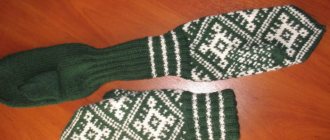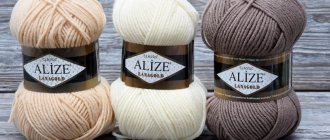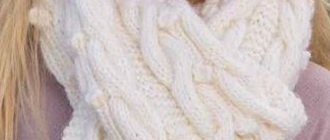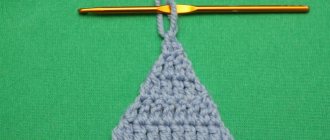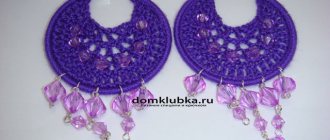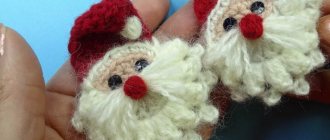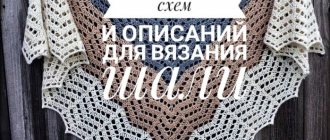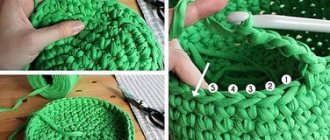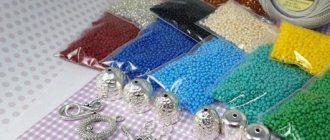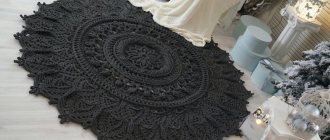When a baby appears in the house - so small and defenseless! – I want to protect him from any dangers. In the first months of life, babies are very tiny, so new mothers take care of them with special trepidation, giving all of themselves 24/7. Since every mother prepares ahead of time for the arrival of a new family member, even during pregnancy she begins to knit tiny socks, booties, and purchases pacifiers, rompers and diapers. So that the baby sleeps peacefully in the first months of his life, without being afraid of his own little hands during sleep, and does not harm himself with a rather sharp first “manicure”, we suggest crocheting simple but very cute scratches for newborns, which will be suitable for any craftswoman. level! You can knit them quickly enough and we only need a small amount of yarn (no more than 20-30 grams). Well, shall we get started?
Choosing yarn for knitting mittens
When choosing yarn for mittens, you need to ensure that it is not only beautiful, but also warm. If the mittens will be worn by a child, then the threads should be hypoallergenic , which will not get wet quickly and can retain heat longer.
For men, coarse thread in rustic shades is traditionally used. If a man spends a lot of time outdoors, then it is better to make double mittens lined with fleece or other “warm” fabric.
Women's mittens come in a variety of colors and patterns, so the thread is chosen so that the pattern is clearly visible on it. And for warmth, you can knit mittens in 2 threads, one of which will be down.
Children's mittens are best knitted from hypoallergenic yarn
The ideal winter yarn is wool. It could be sheep's wool. The downside is that it is prickly, but after a few washes the product becomes quite soft. Goat wool or down is also suitable, but the thread of such yarn is usually thin, so a product made from it should be knitted in several threads or used in pairs with other yarn.
Yarn with a high acrylic content is not expensive, but it does not hold heat well enough and also gets wet quickly. If you knit mittens from such threads, then they need to be additionally insulated with a lining, especially if they are worn by children.
You should especially carefully choose yarn for very young children. It should not cause or provoke the development of allergies.
The following yarn composition is suitable:
| Alpaca | Ideal for small children. Hypoallergenic and retains heat well. |
| Merino | In rare cases, it can cause allergies, but is still recommended for children's products. To reduce the risk of allergic reactions, acrylic can be added to wool. However, the artificial additive will cause heat loss. |
From a maintenance point of view, acrylic mittens are the easiest to care for. They will not be damaged by moths during storage, are easy to wash, and do not form pills. Alpaca mittens are also wearable and do not lose their presentable appearance for a long time, but they should be washed by hand or on the gentle cycle of the washing machine.
It is not recommended to use yarn containing angora. It quickly rolls down, losing its appearance and thermal qualities. For active children aged 2 years and older, it is better to choose a mixture of wool and acrylic. This will allow the mittens to be washed more often with the possibility of drying on a radiator. And you can additionally insulate them by making them double with an inner fleece or knitted part.
Calculation of the amount of yarn by hook number
When starting to knit, it is important to correctly calculate the consumables. Otherwise, at best, there will be unused balls, at worst, there may not be enough thread for the item.
Calculation of the amount of yarn
The hook size is usually indicated on the product and is indicated in millimeters. However, there are products where the marking is not indicated, in addition, the numbers on foreign-made hooks may not correspond to Russian ones.
The hook size is the diameter of the hook head, which can be measured with a caliper. Another way to determine the size is to make a hole with a crochet hook on paper and use a ruler to measure the width of the resulting hole.
When choosing a hook for a specific yarn, you need to ensure that the size matches or is close to the thickness of the thread. This can be checked by placing the thread directly into the hook. The thickness of the thread should not protrude beyond the boundaries of the folded part, but also should not be too loose in the recess.
A mismatch between the hook and the thread will result in the knitted product being either loose or very dense. The packaged skein of yarn will usually indicate the recommended hook size.
You can use it as a guide, but it is always better to knit a sample. Depending on the cost and structure of the yarn, sometimes it is necessary to buy 1 skein in order to correctly calculate the volume that will be required to make the item.
Before crocheting mittens (diagrams and description below), you need to knit a sample of the product
Calculation of thread according to the sample:
- knit a 10 cm x 10 cm sample with the main pattern,
- wash to determine shrinkage,
- count the number of rows and loops in each row,
- unravel the sample and measure the length of the resulting thread,
- Using the pattern of the desired product, you should calculate how many similar samples will fit on it.
By multiplying the number of required squares by the calculation data, you should determine the exact number of rows, loops in a row, as well as the meterage of the threads. The meter of thread and the weight of the skein are always marked on the purchased skein. Accordingly, having calculated the length of the threads, you can determine the number of skeins. It is recommended to buy 50-100 g more threads in case of yarn shrinkage.
In addition, thread consumption will depend on the pattern. Braid patterns always require more yarn, while openwork patterns can, on the contrary, save money. An incorrectly sized hook can also unjustifiably increase yarn consumption.
Helpful tips to make the process enjoyable and efficient
Before crocheting mittens, it is important to take into account the following recommendations:
- It is recommended to wash your hands before knitting.
- It is best to buy yarn with a reserve.
- You should understand the scheme and clearly define the stages of work.
- It is recommended to decide on the size before the process by first measuring your hand and thumb.
- To determine the knitting density, knit a small sample.
- When working, it is better for novice craftsmen to use a special row counter.
- If you need to unravel some part, it is better to use a thin hook.
- To preserve vision, it is recommended to use a light or dark background for knitting.
- The remaining ends after knitting should be crocheted along the row.
To decrease loops when crocheting, it is not recommended to skip the loops of the previous row, but to grab two loops at a time (that is, knit one single crochet over two single crochets of the previous row).
Preparing for knitting
Crochet mittens, diagrams and descriptions of which are given in magazines and on the Internet, complicate the choice of the craftswoman with their variety.
Sizing
An easy way to determine the size and make a pattern for mittens is to trace your palm on paper, with your fingers lying relaxed , slightly apart.
When deciding on the size, you need to make sure that the elastic fits tightly to your wrist, but does not press; The fingers inside should be free, but not too spacious. You can also use the average data from the table if it is not possible to measure your hand.
Pattern selection
Since mittens are crocheted simply and quickly, the craftswoman can knit several products for different looks. Mittens with braids are always in fashion.
Beginners in crocheting can use double crochet or single crochet stitches. If the appearance of such a product seems too simple, it can be “complicated” with strips of yarn of a different color.
Mittens are an accessory where you can use leftover threads, which knitting enthusiasts usually have in abundance.
Crochet mittens, patterns and descriptions of which are offered by the authors, can be designed for different seasons. The colder the season, the denser the fabric should be. Openwork patterns can only be used for products for warm autumn.
Knitting density
The knitting density is affected by:
- selected pattern,
- ratio of hook number and thread thickness,
- thread tension by the craftswoman, which is individual for everyone.
By experimenting with each of these criteria, you can achieve the desired density of the product - make it warmer or less. For example, a classic single crochet stitch will make the item warmer than a single crochet stitch. The thinner the thread relative to the hook, the more gaps there will be between the loops.
At what point should the circular canvas be narrowed?
Once you have knitted enough fabric to completely cover your little finger, gradually begin to narrow the fabric. We reduce the product by decreasing the loops. You need to pull the thread from the last loop (working) and pull it from the adjacent one, knitting the two together with a single crochet.
Next, we knit one single crochet into each loop; this pattern should be used to complete the entire row. In each subsequent row, the number of closed loops decreases until a smooth decrease occurs in all loops.
NOTE!
- DIY rodent craft - interesting ideas
- Knit a tunic - simple patterns and recommendations for choosing models for children and adults (130 photos)
- Knitted overalls for newborns - knitting pattern and description of sewing the best modern models (105 photos)
Crochet mittens for small children: a simple master class for beginners
Mittens designed to look like kittens are suitable for children aged 2 to 4 years. In addition to standard chain stitches, double crochets and single crochets, the work uses embossed stitches. This type of columns gives greater thickness and density.
Thus, knitted mittens will not only keep warm better, but will also be able to stay dry longer, which is important for young children. To prevent the increased density of the product from leading to excessive rigidity, you need to use soft yarn.
Relief columns can be front and back:
- Facial.
The embossed double crochet stitch is made in the same way as a regular double crochet stitch, but the hook should not be threaded through the loop of the previous row, but behind the stitch. Having grabbed the thread, you need to pull it out with a crochet hook and then knit it like a dc.
- Purl.
The purl stitch should be knitted by inserting a hook from the reverse side of the stitch of the bottom row.
For the mittens you will need:
- hook No. 1-1.5,
- yarn with angora, desired colors.
- 4 medium-sized beads for making eyes (color optional from green to black),
- 2 larger beads for the nose (can be replaced with buttons),
- needle,
- black threads, regular sewing threads or floss.
Mitten
First you need to dial 4 air points. and close them in a ring:
- 1st row: you need to tie the air. loops so that you get 11 dc.
- 2-3 row: 2 air.p. for lifting, then in each loop of the row in turn you need to first knit a dc and into it a relief column with the front grip of the lower column. Total – 48 p.
- Rows 4-18: 2 chain stitches on the rise, then you should alternate the relief columns (1 front and 1 back). Total – 48 p.
- On the 19th row it is necessary to make a hole for the thumb part.
- 19 r: 2 air.p. for lifting, sc, chain of 11 air. p., in the 12th loop, sc, you need to finish the row by alternating faces. and out. relief columns.
When knitting the second mitten, remember that the slot for the finger must be placed symmetrically, i.e. not at the beginning, but at the end of the row. Next, knitting the mittens should be continued similarly to rows 4-18 and applied to the child’s palm, achieving the desired length.
Rubber
For the elastic, it is advisable to take yarn in a contrasting color and knit 5 rows in the same pattern as the palm (1 knit stitch, 1 purl stitch).
The final row should consist only of half-columns.
Thumb wrap
When knitting a finger piece, you should start from the wrong side. In the first row, from one edge of the hole you need to make 2 chain stitches, 2 incomplete dcs and knit the resulting loops together. Also knit on the other edge; the rest of the row is knitted with the main pattern.
To determine the length of the finger part, it is recommended to apply it to the hand of the future owner while working. If this is not possible, then you need to knit 8 rows with the main pattern, then pull all the loops together by knitting double crochets together. The thread should be cut, leaving a tip long enough to secure it on the wrong side.
Next, the mittens need to be decorated. For the ears you need to knit 4 triangles. There will be 5 loops at the base, 3 in the next row and then 1 loop. Having attached the 2 parts to each other, they should be sewn together and carefully sewn to the mitten by the base.
Beads must be sewn in place of the eyes. Then use black thread to make a mustache, securing the elongated loops, and sew the cat’s nose on top.
Working on the thumb
We do not knit ten loops to the corner and knit ten air loops. Then, you need to skip 10 stitches of the knitted row and start knitting a single crochet into the 11th loop.
Using exactly the same pattern, you need to knit the hole for the thumb of the left mitten. We continue to create the middle part with a single crochet until its length reaches the little finger of the hand. After this, they usually begin to create the toe of the mitten.
The toe of a mitten in another way is the reduction of the loops of the product within certain four points. Decrease occurs as follows: you need to insert the hook into the loop of the previous knitted row, then grab the thread and pull it onto a new loop. There are now two loops on our hook, so we must insert the hook under the next loop, grab the thread and pull out a new loop. There are already three loops on the hook. We do similar actions, after which we begin to knit with a single crochet to the next of the four points. Let's decrease the stitches again. Such actions are carried out until the end of the row.
Similar decreases in loops are made until approximately 6-7 loops remain on the hook. The loops that remain can be pulled together with a needle by cutting the working thread, leaving a small tail. The resulting tail must be threaded through a needle. The needle must be threaded through each of the loops and pulled together. A thread is secured to the underside of the future mitten.
The thumb is knitted by securing the thread to the inside of the side of the thumb. We knit 2 lifting air loops, 2 n.s.b.n. To avoid holes or gaps, you need to be careful when inserting the hook. Next, we continue to knit a single crochet in a circle to the next side of the mitten. Again it is necessary to knit 2 d.s.b.n., trying not to provoke holes in the product.
The next step is to knit until the end of the circular row using a single crochet. Then you need to close the row with a connecting column. This is done by inserting a hook into a common tip, consisting of two unknitted columns. We continue to knit circular rows in a spiral until we reach the length we need.
The last stage in the master class on knitting mittens for children will be the already familiar steps of decreasing stitches.
You need to insert the hook into the loop of the previous knitted row, then grab the thread and pull it onto a new loop. There are now two loops on our hook, so we must insert the hook under the next loop, grab the thread and pull out a new loop. There are already three loops on the hook. The actions are performed until approximately 4-5 loops remain. They need to be pulled together with a needle, and then the tail of the thread is secured to the wrong side of the completely finished mitten!
Crochet scratches for newborns: instructions
The value of scratches for newborns is difficult to overestimate. As a result of the chaotic hand movements that babies make, they can injure themselves. At best, they will be scared; at worst, an infection may occur in a fragile organism. Therefore, scratches are a necessity. Crochet mittens (patterns and descriptions are simple and accessible to beginners) for newborns are knitted in one evening.
To work you will need:
- threads - cotton of contrasting colors,
- hook – No. 2,
- satin ribbon, thickness 5 mm.
Stages of work:
- It is necessary to make an amigurumi ring. For this you will need pink cotton.
Make a ring-loop 2.5 cm from the tip of the thread. Having passed the working end of the thread between the index and middle fingers, you need to insert the hook into the loop and pull the thread forward.
Next, you should crochet the working thread through the resulting loop. The resulting loop is not taken into account in the calculation. Next, on a large ring you need to knit 6 single crochets and pull the tip of the thread to tighten the ring.
Amigurumi technology is used here to ensure that the hole that always forms at the start of knitting is as invisible as possible.
- In the first row on each loop you should increase 1 sc. There will be a total of 12 loops.
- 2nd row: *sc, increase* (6 times). Total 18 p.
- 3rd row: * 2 sbn, increase * (6 times). Total 24 p.
Then continue knitting with white thread.
- 4-12 p.: 24 p.
- In the 13th row you need to switch to the pink thread again and knit 24 stitches.
- 14 r: 2 lifting loops, ssn, air.p. through 1 loop of the previous row 1 sbn. Until the end of the row you should knit according to the pattern *2dc, dc*. The row of connections ends.
- The 15th row is the final one, it should be knitted with a shell pattern according to the pattern *in the second loop from the hook 5dc, sc*. You need to repeat the pattern along the entire row. Next, the thread must be cut and secured. By analogy, you should knit a mitten on the second hand. You need to thread a ribbon into the resulting holes of the 14th row and tie a bow.
DIY scratches for newborns with diagrams and videos
Your little long-awaited miracle is about to be born, it's time to start preparing a dowry for the baby. Make your own scratch pads for newborns.
Scratchies are small fabric mittens without a finger. They protect the child's face from the chaotic movements of his hands. Since babies have a very strong sucking reflex, this accessory protects newborns from thumb sucking.
Scratchy mittens can be made with elastic or ties; the first option is considered the most convenient. There are many options for how to make scratches, we will look at the most popular ones.
Crochet mittens for boys step by step
Crocheted mittens, with diagrams and descriptions suitable for boys, differ little in technique from mittens for girls.
Currently, manufacturers of children's clothing make bright, multi-colored clothes for boys, so accessories can be not only in traditional men's colors: black, gray, dark blue. The pattern of striped blue and white mittens is designed for boys aged 4-6 years.
Materials for work:
- yarn - 2 colors,
- hook No. 2-3.
Stages of work:
1. Elastic band.
You need to dial 12 air into the chain. p., two of which will be used for lifting. Next you need to do 10 dc and 2 dc. p. for lifting. The cuff should be knitted with a rectangular fabric. Therefore, after each row, the knitting needs to be unrolled.
The next row is also dc, but you should pay attention to the type of knitting of the stitches. The loop of the previous row should be grabbed by the front wall of the loop. Then you should unfold the knitting and knit a dc with a grip on the back wall of the loop of the bottom row.
The elastic should consist of 14 rows, in each of which the grip will alternate when performing the dc. When the elastic band is finished, it must be folded in half and “sewn” from the wrong side along the edge using single crochets, the thread is cut and secured. We decorate the edge of the product with a “crawfish step” binding.
Crochet mittens - patterns and descriptions of knitting mittens for a boy
2. Mitten detail.
You should start knitting the mitten directly with white yarn. The edge of the elastic must be tied with sc so that there are 32 of them. The work must be continued with sc. You need to knit 4 circular rows.
On the 5th row you need to leave a slot for the future part of the thumb. To do this, row 5 is filled with sc to the place where the finger should be. After this, the knitting unfolds and with the help of 1 air. The instep stitch continues in the opposite direction to the location of the second end of the slot for the thumb.
According to the diagram presented, the slot corresponds to 4 loops, but depending on the size of the child’s hand, it can be increased. Having reached the second end of the slot, you need to tie 4 air. etc. and secure them on the other side of the hole.
The work should continue with blue yarn and sc. You need to make 6 rows. Then you need to change the thread back to white and perform 6 more rows. The last stripe in the mitten will be blue. After the white stripe, you need to switch to the blue thread and perform 1 row in the same way as the previous ones.
Next you should start decreasing the loops. Decrease is carried out by 2 loops in each row and only in the places where the mittens are folded, until the fabric is completely closed. The result should be a pattern similar to knitting mittens.
3. Thumb.
The slot left for the finger needs to be tied with 12 sc. And perform 7 more rows with such columns. In the next 2 rows you need to decrease every 2nd stitch. After this, the remaining loops should be closed once, the thread should be cut and secured. The second mitten should be knitted similarly to the first, taking into account the mirror position of the thumb and color transitions.
Working on the thumb
We do not knit ten loops to the corner and knit ten air loops. Then, you need to skip 10 stitches of the knitted row and start knitting a single crochet into the 11th loop.
Using exactly the same pattern, you need to knit the hole for the thumb of the left mitten. We continue to create the middle part with a single crochet until its length reaches the little finger of the hand. After this, they usually begin to create the toe of the mitten.
The toe of a mitten in another way is the reduction of the loops of the product within certain four points. Decrease occurs as follows: you need to insert the hook into the loop of the previous knitted row, then grab the thread and pull it onto a new loop. There are now two loops on our hook, so we must insert the hook under the next loop, grab the thread and pull out a new loop. There are already three loops on the hook. We do similar actions, after which we begin to knit with a single crochet to the next of the four points. Let's decrease the stitches again. Such actions are carried out until the end of the row.
Similar decreases in loops are made until approximately 6-7 loops remain on the hook. The loops that remain can be pulled together with a needle by cutting the working thread, leaving a small tail. The resulting tail must be threaded through a needle. The needle must be threaded through each of the loops and pulled together. A thread is secured to the underside of the future mitten.
Article on the topic: Knitted dress for a girl with knitting patterns and description: practicing knitting for a baby
The thumb is knitted by securing the thread to the inside of the side of the thumb. We knit 2 lifting air loops, 2 n.s.b.n. To avoid holes or gaps, you need to be careful when inserting the hook. Next, we continue to knit a single crochet in a circle to the next side of the mitten. Again it is necessary to knit 2 d.s.b.n., trying not to provoke holes in the product.
The next step is to knit until the end of the circular row using a single crochet. Then you need to close the row with a connecting column. This is done by inserting a hook into a common tip, consisting of two unknitted columns. We continue to knit circular rows in a spiral until we reach the length we need.
The last stage in the master class on knitting mittens for children will be the already familiar steps of decreasing stitches.
You need to insert the hook into the loop of the previous knitted row, then grab the thread and pull it onto a new loop. There are now two loops on our hook, so we must insert the hook under the next loop, grab the thread and pull out a new loop. There are already three loops on the hook. The actions are performed until approximately 4-5 loops remain. They need to be pulled together with a needle, and then the tail of the thread is secured to the wrong side of the completely finished mitten!
Crochet mittens for girls
Crochet mittens, the diagrams and descriptions of which are suitable for older children, require more practicality and must have tightly fastened parts. Satin ribbons and appliqués made of felt and ruffles are not suitable for such products. Mittens knitted for girls aged 6-8 years.
To work you will need:
- yarn of 3 colors - purple, peach and raspberry,
- hook No. 2-3,
- needle.
Stages of work:
1. Elastic band.
You should start working by tying out the air. loops in the amount of 40 pcs. Then the chain must be closed into a ring.
1st row: 3 air. p, *stepping 3 loops of the chain into the 4th one should be knitted together. column, retreating the next 3 points. You need to knit 5 dc*. The pattern should be repeated until the end of the row, except for the last loop, where instead of 5 dc, you need to make 4 dc, which are connected in a chain of air. p. beginning of the row.
2nd row: Changing the color of the thread to peach, you should perform 3 chain stitches. with connect. a column that will be in the middle of the fan of the previous row. The main pattern must be repeated in such a way that 5 dc fall into the gap between the crimson fans and connect. the column was above 3 dc of the bottom row.
Row 3: You need to use purple thread for knitting. You should knit by analogy and make sure that the fan pattern is placed in a checkerboard pattern. From rows 4 to 6 you need to repeat the previous 3 rows.
2. Mitten.
The main part of the mitten should be crimson. From the elastic you need to knit 10 rows of sc. In the next row you need to leave a slot for the thumb. To do this, knit a chain consisting of 9 air. loops, which should be knitted using sc, skipping 9 loops of the previous row.
You need to continue working with the main pattern for another 13 rows. From the 14th row you need to decrease the loops. If it is possible to try on a mitten for a child, then the point of reference for the beginning of the decrease will be the place of the first phalanx of the middle finger - where the finger bends. After the first row with a uniform decrease, there should be 30 stitches left in the row.
In the next row, you need to decrease in every 5 loops. In the remaining rows in every 4th, 3rd, 2nd loop, respectively. In the last row, you need to decrease in each loop, then fasten and cut the thread.
3. Thumb.
The finger should be knitted in a circle, using single crochet stitches. You need to knit 10 rows or a length corresponding to the distance from the base of the thumb to the middle of the nail. Finish knitting the finger by decreasing in each loop, after which fasten and cut the thread.
4. Bow.
To make a bow, you need to knit a chain of air loops, using threads of 3 colors at the same time. From the resulting chain you need to form an even bow and firmly sew it to the mitten.
Male version
This model is suitable for any age. The knitting process is based on an adult. If you need to knit mittens of a smaller size, then you should reduce the number of loops by half (for primary school age). You will need: hook No. 5; any yarn of 2 different colors. Steps for crocheting men's mittens:
- Cast on about 46 loops and connect them, forming a ring and the future base.
- Knit 5-6 rows with an ordinary elastic band (1st row concave with a crochet, 2nd convex with a crochet).
- Then make 2 double crochets.
- You should cast on 6 loops and skip the same number from below.
- Knit approximately 8-9 rows until the end of the little finger.
- Then knit further, decreasing each row by 2 loops.
- Knit the last stitches together and finish the work.
- For the finger, cast on 6 loops and knit similarly to the warp 4-5 centimeters.
- On the last part of the product, decrease the loops, then finish the work.
How to decorate mittens: ideas, description
Options for decorating mittens can only be limited by the imagination and skills of the needlewoman.
For example, you can do:
- Cross stitch of a simple pattern.
- Embroidery can also be done with satin stitch, ribbons, beads or beads.
Any handmade accessories are suitable for decoration. For example, pompoms or buttons.
- Applique with other knitted details.
- Heart applique.
Openwork children's mittens
Mittens using openwork patterns can be knitted for children in the off-season. Acrylic, cotton, and viscose are suitable for such products.
The ease of making crocheted mittens allows you to make several pairs, spending very little time on the work. Thanks to the diagrams and descriptions available on the Internet, each pair can become an original accessory for any clothing.
Author: Vorobyova Nadezhda
Article design: Natalie Podolskaya
